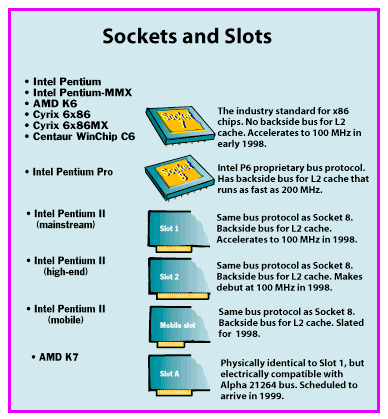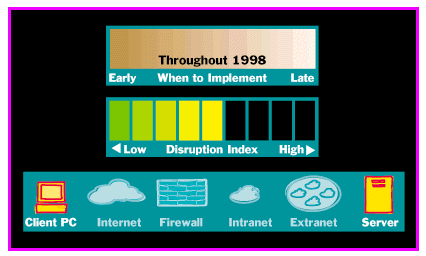| The future direction of the x86-compatible PC platform
will probably be decided in 1998. Or should we say future
directions? At issue is whether the PC platform will
remain a cohesive standard or split into semicompatible
fragments that could force users and vendors to choose
sides. On one side is industry giant Intel, which makes about 90 percent of the x86 microprocessors in today's PCs. On the other side are Advanced Micro Devices, Cyrix, and Centaur Technology, three smaller companies who fight over the remaining 10 percent. Dissatisfied with table scraps, they want to grab more market share and challenge Intel's technology lead. To keep them at bay, Intel is developing even better processors — and is changing the ground rules. Today, all four companies make CPU chips that fit a standard CPU interface called Socket 7. But Intel's P6-class processors — the Pentium Pro and the Pentium II — use a different bus protocol that delivers higher performance. It's also heavily patented and difficult to clone. It comes with a slew of new physical interfaces that are incompatible with Socket 7: Socket 8 (Pentium Pro), Slot 1 (mainstream Pentium II), Slot 2 (high-end Pentium II), and a miniature Slot 1 for future Pentium II notebook computers. In response, the other x86 vendors will boost Socket 7's bus frequency from today's 66 MHz to a new high of 100 MHz. The 50 percent faster bus will appear in new CPUs, system chip sets, and motherboards in early 1998. That will match Intel's 100-MHz P6 bus, which is due in the same period when Intel releases the 440BX chip set. Intel's P6 interface still has the advantage of a separate bus for the off-chip Level 2 (L2) cache. To counter that advantage, AMD and Centaur have announced that their new CPUs in late 1998 will integrate a 256-KB L2 cache directly on the chip. And those CPUs will fit Socket 7. Watch for Cyrix to announce a similar stopgap solution. But in the long run, Intel's chipmaking rivals must either clone the proprietary P6 bus or invent a completely new interface. AMD is taking the second course. Its next-generation K7 chip (due in 1999) will join an x86 core to the bus interface of Digital's Alpha 21264. The K7 will fit a new slot that's physically — but not electrically — compatible with Intel's Slot 1. Future Alpha processors and system chip sets will also be compatible with this slot. A key event to watch for in 1998 will be whether Cyrix and Centaur go along with AMD's plan. Where to Find
Advanced Micro Devices
Sockets and Slots Advanced Micro Devices for 1998 WHO SUPPORTS IT: Intel versus AMD, Cyrix, and Centaur Technology. Copyright 1994-1998 BYTE |